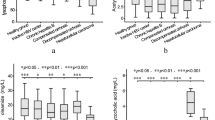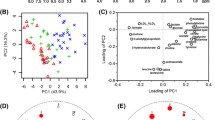Abstract
Liver failure induced by hepatitis B virus (HBV) is a severe disease with a high mortality rate. Liver support treatment is a powerful method for treating liver failure and is a bridge to liver transplantation. Patients with similar liver function indices, however, have different outcomes following treatment, and no satisfying prediction parameters exist. In this study, we used ultraperformance liquid chromatography-mass spectrometry (UPLC-MS) to investigate plasma metabolites in groups of acute-on-chronic liver failure patients with different prognosis. An orthogonal partial least squares (OPLS) model, with satisfactory explanatory and predictive ability (R 2 Y = 0.943, Q 2 = 0.913) was established using SIMCA-P + 12.0. The model was based on samples collected just before the first artificial treatment for comparable model efficacy. The concordance statistics of our model was 0.968 (95% CI [0.951, 0.985]) which is superior to that of the MELD (the Model for End-stage Liver Diseases) score (0.737, 95% CI [0.578, 0.896]). Three groups of markers were identified: lysophosphatidylcholine, primary fatty acid amides and conjugated bile acids. Lysophosphatidylcholine and conjugated bile acids were protection factors for survival and primary fatty acid amides were risk factors. The cut-off point for the predictive value of our model was greater than or equal to 0.196, at which the model showed the best discrimination between the recovery and non-recovery groups, with a sensitivity of 95% and a specificity of 87%. This metabolomic model, based on plasma UPLC-MS profiles, provides not only excellent discrimination and prognostic ability for HBV-induced acute-on-chronic liver failure but also early and precise warning of possible liver transplantation.








Similar content being viewed by others
References
Antoniades, C. G., Berry, P. A., Wendon, J. A., & Vergani, D. (2008). The importance of immune dysfunction in determining outcome in acute liver failure. Journal of Hepatology, 49, 845–861.
Bernal, W. (2010). Lactate is important in determining prognosis in acute liver failure. Journal of Hepatology, 53, 209–210.
Bernal, W., Donaldson, N., Wyncoll, D., & Wendon, J. (2002). Blood lactate as an early predictor of outcome in paracetamol-induced acute liver failure: A cohort study. Lancet, 359, 558–563.
Boger, D. L., Fecik, R. A., Patterson, J. E., Miyauchi, H., Patricelli, M. P., & Cravatt, B. F. (2000). Fatty acid amide hydrolase substrate specificity. Bioorganic & Medicinal Chemistry Letters, 10, 2613–2616.
Chen, Y. S., Wu, Z. W., He, J. Q., Yu, J., Yang, S. G., Zhang, Y. M., et al. (2007). The curative effect of ALSS on 1-month mortality in AoCLF patients after 72 to 120 hours. The International Journal of Artificial Organs, 30, 906–914.
Cravatt, B. F., Giang, D. K., Mayfield, S. P., Boger, D. L., Lerner, R. A., & Gilula, N. B. (1996). Molecular characterization of an enzyme that degrades neuromodulatory fatty-acid amides. Nature, 384, 83–87.
Cravatt, B. F., Saghatelian, A., Hawkins, E. G., Clement, A. B., Bracey, M. H., & Lichtman, A. H. (2004). Functional disassociation of the central and peripheral fatty acid amide signaling systems. Proceedings of the National Academy of Sciences of the United States of America, 101, 10821–10826.
Dhiman, R. K., Jain, S., Maheshwari, U., Bhalla, A., Sharma, N., Ahluwalia, J., et al. (2007). Early indicators of prognosis in fulminant hepatic failure: An assessment of the Model for End-Stage Liver Disease (MELD) and King’s College Hospital criteria. Liver Transplantation, 13, 814–821.
DI Campli, C., Zocco, M. A., Gaspari, R., Novi, M., Candelli, M., Santoliquido, A., et al. (2005). The decrease in cytokine concentration during albumin dialysis correlates with the prognosis of patients with acute on chronic liver failure. Transplantation Proceedings, 37, 2551–2553.
Driscoll, W. J., Chaturvedi, S., & Mueller, G. P. (2007). Oleamide synthesizing activity from rat kidney: Identification as cytochrome c. The Journal of Biological Chemistry, 282, 22353–22363.
Du, W. B., Li, L. J., Huang, J. R., Yang, Q., Liu, X. L., Li, J., et al. (2005). Effects of artificial liver support system on patients with acute or chronic liver failure. Transplantation Proceedings, 37, 4359–4364.
Giang, D. K., & Cravatt, B. F. (1997). Molecular characterization of human and mouse fatty acid amide hydrolases. Proceedings of the National Academy of Sciences of the United States of America, 94, 2238–2242.
Huang, Y. H., Schafer-Elinder, L., Wu, R., Claesson, H. E., & Frostegard, J. (1999). Lysophosphatidylcholine (LPC) induces proinflammatory cytokines by a platelet-activating factor (PAF) receptor-dependent mechanism. Clinical and Experimental Immunology, 116, 326–331.
Kamath, P. S., Wiesner, R. H., Malinchoc, M., Kremers, W., Therneau, T. M., Kosberg, C. L., et al. (2001). A model to predict survival in patients with end-stage liver disease. Hepatology, 33, 464–470.
Kim, W. R., Biggins, S. W., Kremers, W. K., Wiesner, R. H., Kamath, P. S., Benson, J. T., et al. (2008). Hyponatremia and mortality among patients on the liver-transplant waiting list. New England Journal of Medicine, 359, 1018–1026.
Kjaergard, L. L., Liu, J., Als-Nielsen, B., & Gluud, C. (2003). Artificial and bioartificial support systems for acute and acute-on-chronic liver failure: A systematic review. JAMA, 289, 217–222.
Li, N., Li, Q., Qian, Z., Zhang, Y., Chen, M., & Shi, G. (2009). Impaired TLR3/IFN-beta signaling in monocyte-derived dendritic cells from patients with acute-on-chronic hepatitis B liver failure: Relevance to the severity of liver damage. Biochemical and Biophysical Research Communications, 390, 630–635.
Lin, S. D., Kawakami, T., Ushio, A., Sato, A., Sato, S., Iwai, M., et al. (2006). Ratio of circulating follistatin and activin A reflects the severity of acute liver injury and prognosis in patients with acute liver failure. Journal of Gastroenterology and Hepatology, 21, 374–380.
Lindon, J. C., Nicholson, J. K., & Holmes, E. (Eds.). (2008). The handbook of metabonomics and metabolomics. Beijing: Science Press.
Liver Failure and Artificial Liver Group, C. S. O. I. D., Chinese Medical Association & Severe Liver Diseases and Artificial Liver Group, C. S. O. H., Chinese Medical Association. (2006). Diagnostic and treatment guidelines for liver failure. Zhonghua Gan Zang Bing Za Zhi, 14, 643–646.
Macquillan, G. C., Seyam, M. S., Nightingale, P., Neuberger, J. M., & Murphy, N. (2005). Blood lactate but not serum phosphate levels can predict patient outcome in fulminant hepatic failure. Liver Transplantation, 11, 1073–1079.
Montejo Gonzalez, J. C., Catalan Gonzalez, M., Meneu Diaz, J. C., Moreno Elola-Olaso, A., De La Cruz, J., & Moreno Gonzalez, E. (2009). Artificial liver support system in acute liver failure patients waiting liver transplantation. Hepato-Gastroenterology, 56, 456–461.
O’grady, J. G., Alexander, G. J., Hayllar, K. M., & Williams, R. (1989). Early indicators of prognosis in fulminant hepatic failure. Gastroenterology, 97, 439–445.
Olofsson, K. E., Andersson, L., Nilsson, J., & Bjorkbacka, H. (2008). Nanomolar concentrations of lysophosphatidylcholine recruit monocytes and induce pro-inflammatory cytokine production in macrophages. Biochemical and Biophysical Research Communications, 370, 348–352.
Piotto, M., Moussallieh, F. M., Dillmann, B., Imperiale, A., Neuville, A., Brigand, C., et al. (2009). Metabolic characterization of primary human colorectal cancers using high resolution magic angle spinning 1H magnetic resonance spectroscopy. Metabolomics, 5, 292–301.
Polson, J., & Lee, W. M. (2005). AASLD position paper: The management of acute liver failure. Hepatology, 41, 1179–1197.
Quinn, M. T., Parthasarathy, S., & Steinberg, D. (1988). Lysophosphatidylcholine: A chemotactic factor for human monocytes and its potential role in atherogenesis. Proceedings of the National Academy of Sciences of the United States of America, 85, 2805–2809.
Radu, C. G., Yang, L. V., Riedinger, M., Au, M., & Witte, O. N. (2004). T cell chemotaxis to lysophosphatidylcholine through the G2A receptor. Proceedings of the National Academy of Sciences of the United States of America, 101, 245–250.
Ren, F., Chen, Y., Wang, Y., Yan, Y., Zhao, J., Ding, M., et al. (2010). Comparative serum proteomic analysis of patients with acute-on-chronic liver failure: Alpha-1-acid glycoprotein maybe a candidate marker for prognosis of hepatitis B virus infection. Journal of Viral Hepatitis, 17, 816–824.
Schiodt, F. V., Ostapowicz, G., Murray, N., Satyanarana, R., Zaman, A., Munoz, S., et al. (2006). Alpha-fetoprotein and prognosis in acute liver failure. Liver Transplantation, 12, 1776–1781.
Schiodt, F. V., Rossaro, L., Stravitz, R. T., Shakil, A. O., Chung, R. T., & Lee, W. M. (2005). Gc-globulin and prognosis in acute liver failure. Liver Transplantation, 11, 1223–1227.
Schmidt, L. E., & Dalhoff, K. (2002). Serum phosphate is an early predictor of outcome in severe acetaminophen-induced hepatotoxicity. Hepatology, 36, 659–665.
Schmidt, L. E., & Larsen, F. S. (2010). Is lactate concentration of major value in determining the prognosis in patients with acute liver failure? Hardly. Journal of Hepatology, 53, 211–212.
Shepherd, L., Alexander, C., Sungurtas, J., Mcnicol, J., Stewart, D., & Davies, H. (2010). Metabolomic analysis of the potato tuber life cycle. Metabolomics, 6, 274–291.
Sun, Q. F., Ding, J. G., Xu, D. Z., Chen, Y. P., Hong, L., Ye, Z. Y., et al. (2009). Prediction of the prognosis of patients with acute-on-chronic hepatitis B liver failure using the model for end-stage liver disease scoring system and a novel logistic regression model. Journal of Viral Hepatitis, 16, 464–470.
Wei, B. Q., Mikkelsen, T. S., Mckinney, M. K., Lander, E. S., & Cravatt, B. F. (2006). A second fatty acid amide hydrolase with variable distribution among placental mammals. The Journal of Biological Chemistry, 281, 36569–36578.
Whitfield, P., Noble, P.-J., Major, H., Beynon, R., Burrow, R., Freeman, A., et al. (2005). Metabolomics as a diagnostic tool for hepatology: Validation in a naturally occurring canine model. Metabolomics, 1, 215–225.
Wiklund, S., Johansson, E., Sjostrom, L., Mellerowicz, E. J., Edlund, U., Shockcor, J. P., et al. (2008). Visualization of GC/TOF-MS-based metabolomics data for identification of biochemically interesting compounds using OPLS class models. Analytical Chemistry, 80, 115–122.
Xing, T., Li, L., Cao, H., & Huang, J. (2007). Altered immune function of monocytes in different stages of patients with acute on chronic liver failure. Clinical and Experimental Immunology, 147, 184–188.
Yamagishi, Y., Saito, H., Ebinuma, H., Kikuchi, M., Ojiro, K., Kanamori, H., et al. (2009). A new prognostic formula for adult acute liver failure using computer tomography-derived hepatic volumetric analysis. Journal of Gastroenterology, 44, 615–623.
Yamagishi, Y., Saito, H., Tada, S., Horie, Y., Kato, S., Ishii, H., et al. (2005). Value of computed tomography-derived estimated liver volume/standard liver volume ratio for predicting the prognosis of adult fulminant hepatic failure in Japan. Journal of Gastroenterology and Hepatology, 20, 1843–1849.
Yang, J., Zhao, X., Liu, X., Wang, C., Gao, P., Wang, J., et al. (2006). High performance liquid chromatography-mass spectrometry for metabonomics: Potential biomarkers for acute deterioration of liver function in chronic hepatitis B. Journal of Proteome Research, 5, 554–561.
Yantorno, S. E., Kremers, W. K., Ruf, A. E., Trentadue, J. J., Podesta, L. G., & Villamil, F. G. (2007). MELD is superior to King’s college and Clichy’s criteria to assess prognosis in fulminant hepatic failure. Liver Transplantation, 13, 822–828.
Yasumi, Y., Takikawa, Y., Endo, R., & Suzuki, K. (2007). Interleukin-17 as a new marker of severity of acute hepatic injury. Hepatology Research, 37, 248–254.
Zaman, M. B., Hoti, E., Qasim, A., Maguire, D., Mccormick, P. A., Hegarty, J. E., et al. (2006). MELD score as a prognostic model for listing acute liver failure patients for liver transplantation. Transplantation Proceedings, 38, 2097–2098.
Acknowledgments
Here I thank Dr. Zonghui Ding from the Second Affiliated Hospital, School of Medicine, Zhejiang University for his help in R statistics and thoughtful discussion. The work was supported by National S&T Major Project for Infectious Disease Control of China (2008ZX10002-05) and the National Natural Science Foundation of China (30630023).
Author information
Authors and Affiliations
Corresponding author
Electronic supplementary material
Below is the link to the electronic supplementary material.
Rights and permissions
About this article
Cite this article
Hao, S., Xin, J., Lian, J. et al. Establishing a metabolomic model for the prognosis of hepatitis B virus-induced acute-on-chronic liver failure treated with different liver support systems. Metabolomics 7, 400–412 (2011). https://doi.org/10.1007/s11306-010-0260-5
Received:
Accepted:
Published:
Issue Date:
DOI: https://doi.org/10.1007/s11306-010-0260-5




